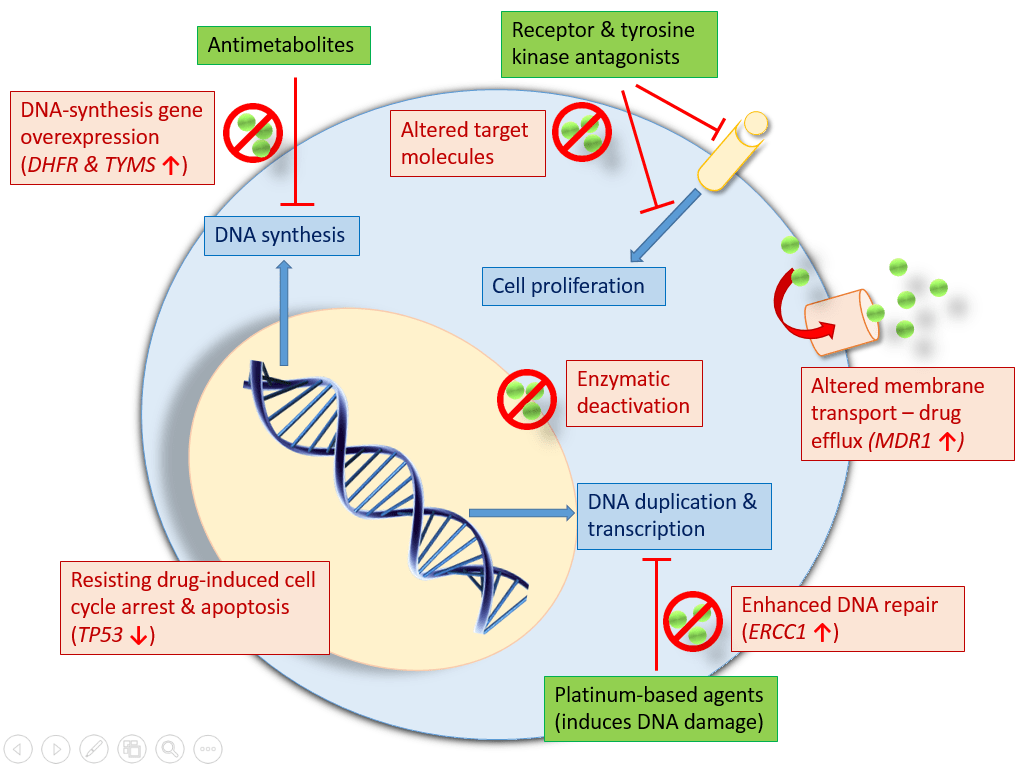Anticancer drugs: Anticancer drugs can be divided into classes depending on similar mechanisms of action, as follows.
Alkylating agents: Alkylating agents act directly on DNA, causing cross-linking of DNA strands, abnormal base pairing, or DNA strand breaks, thus preventing the cell from dividing. Alkylating agents are generally considered to be cell cycle phase nonspecific, meaning that they kill the cell in various and multiple phases of the cell cycle. They are effective at treating slow-growing cancers. They include chlorambucil, cyclophosphamide, thiotepa, ifosfamide, nitrosoureas (carmustine), melphalan and busulfan. Platinum containing alkylating agents include cisplatin, carboplatin and oxaliplatin. In addition to DNA damage, platinum containing agents also disrupt cell membrane transport and suppress mitochondrial function.
Antimetabolites: They replace natural substances as building blocks in DNA molecules, thus affecting metabolism and protein synthesis. Antimetabolites are cell cycle specific. They are most effective during the S-phase of cell division because they primarily act upon cells undergoing synthesis of new DNA for formation of new cells. The toxicities associated with these drugs are seen in cells that are growing and dividing quickly (think GIT and bone marrow). Examples of antimetabolites include purine and pyrimidine antagonists such as 5FU (fluorouracil), cytosine arabinoside and folate antagonists such as methotrexate. Hypomethylating agents such as 5-azacytidine and decitabine act as antimetabolites by affecting cytokine signalling.
Methotrexate is an inhibitor of dihydrofolate reductase which decreases the synthesis of thymidylate and purines hence inhibits DNA synthesis and protein metabolism.
Purine antimetabolite mercaptopurine is a prodrug that is activated by the enzyme HGPRT (hypoxanthine guanine phosphoribosyltransferase) to toxic nucleotides. It is inactivated by the enzyme xanthine oxidase. When a xanthine oxidase inhibitor drug like allopurinol is used concomitantly, the dose of mercaptopurine needs to be lowered.
5 FU is an inhibitor of thymidylate synthase.
Plant alkaloids and antitumor agents: These plant derived drugs block cell division by binding to microtubule proteins and are most effective during the S and M phases of the cell cycle. They include vinca alkaloids (derived from periwinkle plant) vincristine, vinblastine; taxanes including paclitaxel and docetaxel; podophyllotoxins like etoposide and teniposide and camptothecans including irinotecan and topotecan. Podophyllotoxins and camptothecins are also called topoisomerase inhibitors.
Topotecan and irinotecan are inhibitors of topoisomerase I.
Etoposide and teniposide are inhibitors of topoisomerase II.
Antitumor antibiotics (anthracyclines): They act by binding with DNA, intercalating between base pairs and preventing RNA synthesis. They cause uncoiling of DNA strands. Examples are doxorubicin, daunorubicin, mitoxantrone, and bleomycin
Miscellaneous: It is a mixed group and includes drugs like imatinib, trastuzumab, tamoxifen etc.
